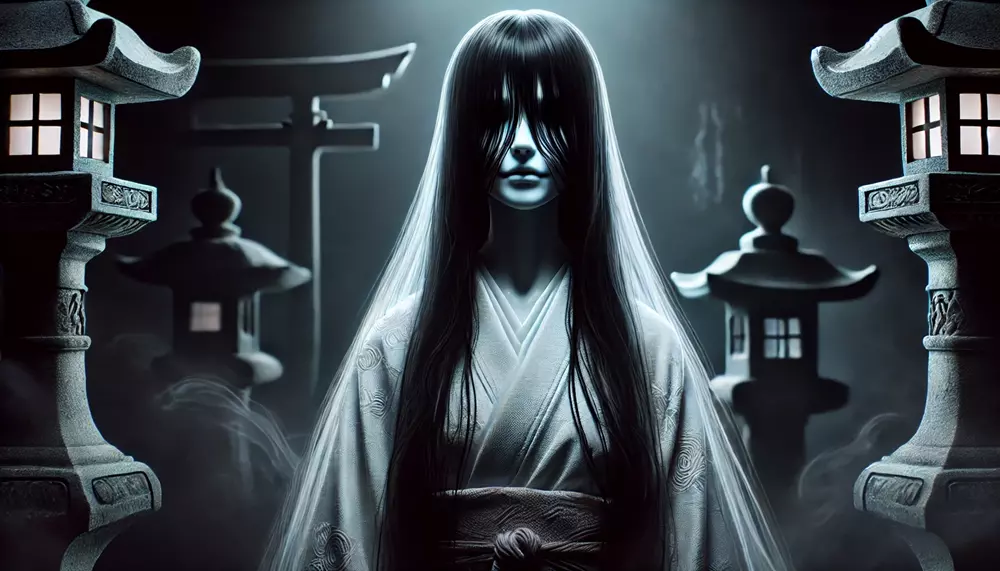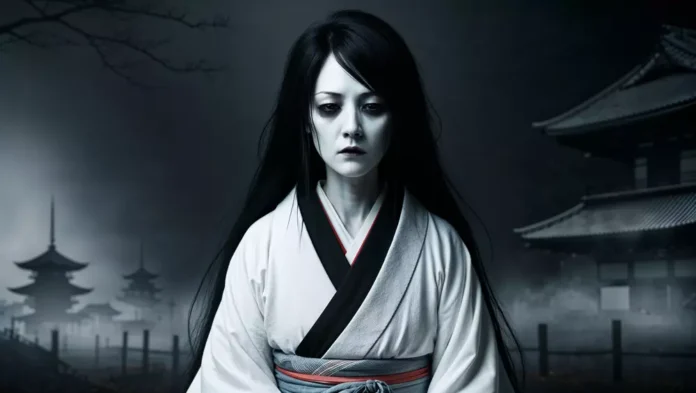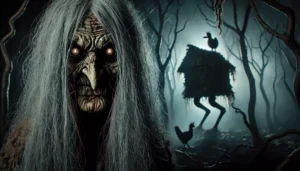Introduction
Yurei are traditional Japanese spirits often depicted as ghostly, haunting figures wrapped in sorrow or anger. Originating in Edo-period folklore, these entities embody unresolved emotions, such as vengeance, sadness, or duty left unfulfilled. Their depiction typically includes long black hair, pale skin, and white funeral attire, making them icons of Japanese supernatural imagery. Yurei are closely associated with tales of betrayal and unfinished business, drawing on cultural beliefs surrounding death and the afterlife. Their influence spans both historical stories and modern pop culture, appearing in literature, films, and haunted legends across Japan.
History/Origin
Yurei’s origins trace back to Japan’s Edo period (1603-1868), a time when ghost stories gained popularity, and supernatural tales were shared as forms of entertainment and caution. The term “Yurei” itself, combining the characters 幽 (yū, meaning faint or dim) and 霊 (rei, meaning spirit or soul), reflects the nature of these spirits as fleeting, residual presences tied to powerful emotions or unfinished tasks. Early depictions of Yurei in ukiyo-e woodblock prints show them with the recognizable white burial kimono and wild, flowing hair, a look intended to evoke both their ethereal quality and the separation from the world of the living.
One of the earliest recorded stories of Yurei is that of Oiwa, a wronged woman whose tragic tale of betrayal and death comes from Yotsuya Kaidan, a kabuki play written by Tsuruya Nanboku in 1825. The play tells the story of Oiwa’s husband betraying her for another woman, leading to Oiwa’s slow death and transformation into a vengeful Yurei. This powerful tale became widely popular in Edo-period Japan, with the following quote from the play exemplifying the Yurei’s despair and wrath: “Even in death, my pain shall be known, my face shall haunt you” (Yotsuya Kaidan). This tale encapsulates the qualities that define Yurei—vengeance, sorrow, and a haunting presence.
Another notable reference is the story of Okiku, a servant girl who, after a tragic betrayal and death, is said to haunt Himeji Castle, counting her dishes and wailing in sorrow. The legend of Okiku and her eternal counting highlights the aspect of repetition in Yurei myths, as unresolved obsessions and tragic endings bring these spirits back to haunt the places they once knew.
Name Meaning
The name Yurei (幽霊) is composed of two kanji characters that translate to “faint spirit.” This term encapsulates the essence of Yurei as ethereal beings caught between worlds. The notion of “faint” or “dim” speaks to their incomplete existence, symbolizing spirits unable to move on due to lingering emotions, grievances, or unfinished business. The use of “rei” connects Yurei to the broader Japanese belief in spirits and ancestral worship, where spirits are often respected and feared as powerful forces. Over time, Yurei has come to represent ghostly apparitions bound by sorrow or vengeance.
Background Story
One of the most famous Yurei stories is that of Oiwa from the kabuki play Yotsuya Kaidan. Oiwa, a loyal but tragically mistreated wife, was poisoned by her husband, Tamiya Iemon, so he could marry another woman. The poison caused Oiwa’s face to become disfigured, and she suffered a slow and painful death. In her final moments, Oiwa’s spirit became consumed with rage and sorrow, vowing to haunt her husband eternally. Following her death, her ghost began appearing to him, her face twisted with pain and her hair cascading wildly around her. The play describes her haunting appearance vividly: “Her eyes stare through his soul, her face a mask of sorrow and vengeance.” This classic tale of Yurei demonstrates the thematic elements of betrayal and tragic endings that bring Yurei back to haunt the world of the living.

Another popular story is that of Okiku, a maid wrongfully accused of losing valuable plates. Her master threw her down a well in a fit of rage. After her death, her spirit haunted the well, forever counting the plates, a mournful reminder of the injustice done to her. This haunting repetition symbolizes how Yurei’s pain lingers, as unresolved grievances tether them to the physical world.
Cultural Impact
Yurei’s influence on Japanese culture extends beyond folklore and into rituals, visual arts, and literary traditions. During the Edo period, ghost stories about Yurei became popular summer entertainment, when storytelling circles known as hyaku monogatari (one hundred stories) would gather to recount eerie tales. Participants would light one hundred candles, extinguishing each one as a story ended until only one candle remained, summoning an atmosphere ripe for invoking Yurei.
Yurei are also central to Obon, a Japanese festival honoring the spirits of deceased ancestors. During Obon, families welcome the spirits back to their homes, symbolizing a temporary union between the living and the dead. Although not specifically focused on Yurei, the festival incorporates the respect and awareness of spirits that underscore Yurei tales.
Artistically, Yurei were immortalized by ukiyo-e artist Maruyama Okyo, whose ghost paintings (reijin) portray the spectral beauty and haunting sadness associated with these figures. The Yurei image, characterized by long, unkempt hair and flowing burial attire, has become iconic in Japanese art, embodying beauty and sorrow. Okyo’s work, including his famed piece, “The Ghost of Oyuki,” exemplifies the haunting aesthetics of Yurei, emphasizing their ethereal presence: “With silent grace, her form drifts through the night, embodying sorrow” (The Ghost of Oyuki).
Similar Beasts
Banshee (Irish folklore) – Like Yurei, Banshees are ghostly figures tied to sorrow and death. They are said to wail or scream to foretell the death of family members, embodying grief and an ominous warning.
La Llorona (Mexican folklore) – Known as “The Weeping Woman,” La Llorona is the spirit of a mother searching for her lost children, often near water. Her sorrow and haunting cries mirror Yurei’s ties to loss and longing.
Poltergeist (European folklore) – Poltergeists are restless spirits associated with chaos and disturbance, known for their physical manifestations in the world of the living. Though less motivated by sorrow, they share Yurei’s unsettling, often malevolent presence.
Preta (Hindu and Buddhist mythology) – Preta are “hungry ghosts,” spirits cursed with insatiable desires due to their actions in life. Like Yurei, they remain in the physical world, symbolizing the consequences of unresolved issues.
Draugr (Norse folklore) – Draugr are vengeful spirits or reanimated corpses from Norse mythology, often returning to exact revenge on the living. Their violent retribution resembles Yurei’s pursuit of justice or revenge against those who wronged them.
These similar beings reveal a common thread across cultures: the belief that intense emotions or unfinished business can trap spirits in the human world. Each represents a haunting reminder of unresolved feelings, with the Yurei standing out for their uniquely Japanese representation of sorrow, beauty, and vengeance.
Religion/Ritual
Yurei are intrinsically connected to Japanese beliefs about death and the afterlife. According to Shinto and Buddhist traditions, when a person dies, their spirit should join the ancestral ranks if all proper rites and ceremonies are performed. However, if they die suddenly, violently, or with unresolved emotional turmoil, they may become a Yurei. To prevent the transformation into Yurei, it is essential to perform purification and proper funeral rites.
In Japanese Buddhism, the act of chanting sutras and prayers is believed to help guide spirits to peace, reducing the risk of a Yurei’s return. There is also a strong belief in the power of omamori (protective amulets) and other sacred objects to ward off Yurei. These rituals reflect the cultural and religious fear of vengeful spirits, as well as the reverence for spiritual purification to maintain harmony between the worlds of the living and the dead.
Scientific or Rational Explanations
The legends of Yurei can be attributed to psychological and cultural factors as well. Some scholars suggest that stories of Yurei reflect societal fears and moral lessons about betrayal, jealousy, and the importance of ethical behavior. Folklorists argue that Yurei served as cautionary tales, discouraging actions that could lead to tragic consequences. For example, Yotsuya Kaidan highlights themes of betrayal and fidelity, teaching moral lessons through supernatural consequences.
Scientifically, it is also possible that visual anomalies, such as illusions created in low light, fueled these ghostly tales. The long shadows and misty landscapes common in Japan’s rural areas contribute to a sense of the uncanny, heightening the eerie atmosphere ideal for Yurei encounters.
In Modern Culture
Yurei’s haunting presence has made a significant impact on modern popular culture, particularly through cinema and literature. Here are five prominent examples:
The Ring (Ringu) – The iconic Japanese horror film features Sadako, a Yurei-like figure emerging from a well to haunt those who watch a cursed videotape. Her long hair and slow movements epitomize the Yurei’s eerie aesthetic, rooted in the Okiku legend.

Ju-On (The Grudge) – Another Japanese horror classic, this film portrays Kayako, a vengeful Yurei spirit haunting a cursed house. Her spectral appearance and haunting groans have become symbols of Yurei-inspired terror, impacting international horror genres.
Spirited Away – Although not a horror film, Hayao Miyazaki’s Spirited Away includes Yurei-like spirits in its bathhouse setting, highlighting Japan’s cultural reverence for the spirit world. The film’s ghostly creatures reflect Yurei’s influence on the portrayal of spirits.
Dark Water – This psychological horror film centers on a mother and daughter haunted by a spirit reminiscent of Yurei, tapping into fears of betrayal and loss. The film’s themes of unresolved sadness echo Yurei’s traditional stories.
Death Note – While not about Yurei directly, Death Note incorporates elements of Japanese death lore and features a haunting, spectral atmosphere that draws on similar themes of vengeance and the consequences of death, echoing the psychological tension found in Yurei myths.
Conclusion
Yurei’s haunting legacy in Japanese culture continues to be a profound symbol of unresolved emotions and supernatural forces. These spirits embody themes of sorrow, vengeance, and unfulfilled duty, reflecting cultural values and moral tales deeply embedded in Japanese society. Through rituals, artwork, and storytelling, Yurei’s image remains a powerful force, capturing imaginations and evoking a sense of eerie beauty that transcends time. From Edo-period kabuki plays to modern horror films, Yurei has left an indelible mark on both traditional and popular culture, proving that the stories of the past continue to resonate with audiences today.




